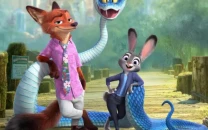Film review: The elephant in the room
Everything leads up to a cinematic disaster, thanks to sloppy direction and predictable character details.

Let me lay it on the line for you: Frances Lawrence’s Water For Elephants is not a good film. It’s barely even a mediocre film. What it mostly is, is a hugely disappointing film that misses making the most of a number of cinematic opportunities. And while a straight out bad film can be forgiven, a mediocre and boring film will simply be forgotten.
The film is set in America in the Great Depression and is about a young Polish-American, Jacob (Robert Pattinson), who is made suddenly destitute a few hours before he is to graduate as a vet from Cornell University. In what feels like a desperate attempt to get what screenwriter Richard LaGravenese probably thought of as an emotional rollercoaster started, Jacob leaves town and hitches a ride on a random train, which turns out to be that of the Benzini Brothers’ travelling circus. Some minor altercations aside, Jacob joins the circus as a vet and elephant trainer but has enough spare time to begin an awkward flirtation with the circus owner and ringmaster’s wife (Reese Witherspoon), as well as a strange stilted ‘friendship’ with the ringmaster himself (Christopher Waltz).
What happens in the rest of the film is predictable, boring and is barely even pretending to be the emotional rollercoaster the screenwriter was hoping for. The one big event that everything leads up to is a cinematic disaster, thanks to sloppy direction and predictable character deaths. The conclusion is just too neat, tidy and contrived to be of any value at all. No lessons are learnt, no characters are developed; there is no change in pace, no build up, no real sense of denouement, no cathartic release — the entire film plays out like the electrocardiogram of Robert Pattinson’s acting skills: it’s a flatliner.
Although both Reese Witherspoon and Christopher Waltz have won Oscars, Screen Actors Guild awards and Golden Globes, it’s really only one of them who brings anything to the table in Water for Elephants. Christopher Waltz is the film’s single redeeming feature but sadly he can’t carry the entire film on his shoulders alone. He tries as best as he can to play the subtleties and complexities of August, the manic, repressed, violently cruel ringmaster, but there are really only so many subtleties one man can play on in a film where good and evil characters are so very clear. Even then, it plays to Waltz’ credit that although he is meant to be the clear villain of the piece, it is easier to connect with him than with the protagonists.
There is zero chemistry between the leads — all three of them. Waltz is by far superior to the rest (surprisingly he’s billed third) but there still is no chemistry between him and Witherspoon. Even the best of actors can not form a connection with wooden counterparts — no one could. And while Witherspoon may have taken home awards for her performance as June Carter Cash in Walk in the Line, here she barely scratches the surface of a character that could have a great deal to offer. So much about her is simply unrealistic — it is a dirty, flea-bitten circus, yet Witherspoon’s character manages to remain perfectly coiffed and dressed like a ‘30s pin up model at any given time. But even with her bottle blonde steel-tight curls, her slinky dresses and spangled circus outfits, she is awkward, self-conscious and unlike the ideal of the sexy woman in the ‘30s, she is so thin she appears brittle. Give me back the sexy, savvy Elle Woods of Legally Blonde any day.
Sadly, very often the elephant in the room really is the only thing worth talking about. Rosie understands Polish! She can do headstands! She can balance on a tiny stool! That’s more of an achievement than Robert Pattinson’s entire acting career will ever result in.
There was so much savagery and colour in circus life during the Great Depression, so many burlesque spectacles and drama that could have made for a rich film with deep, lush visuals. But what we’re served up is a lukewarm with just the hint of something truly cinematic. The romance of circus life and the colour of carnival should resonate in a film like this, but disappointingly, very few scenes live up to their potential. The film is without texture and is peppered randomly with a number of characters who are not given enough screen time to establish themselves and so remain on the sidelines, like minor insignificant accessories. There are a few attempts at capturing a little of the circus’ tawdry side, but once again, these remain attempts. The carnival raunchiness that managed to run deeply through the source material, a book of the same name by Sara Gruen, is not explored by Lawrence.
This is one film that isn’t going to help the sales of the book. Is this animal movie? Is this a romantic drama? There are animals. There is romance, there is drama. There just isn’t enough of anything at all.
Published in The Express Tribune, Sunday Magazine, May 15th, 2011.
This article has been revised to reflect the following correction:
Correction: May 20, 2011
An earlier version of this article incorrectly stated ‘30s as '50s at two instances.



















COMMENTS
Comments are moderated and generally will be posted if they are on-topic and not abusive.
For more information, please see our Comments FAQ